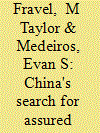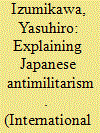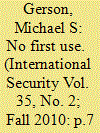|
|
|
Sort Order |
|
|
|
Items / Page
|
|
|
|
|
|
|
| Srl | Item |
| 1 |
ID:
098660


|
|
|
|
|
| Publication |
2010.
|
| Summary/Abstract |
After exploding its first nuclear device in 1964, China did not develop sufficient forces or doctrine to overcome its vulnerability to a first strike by the United States or the Soviet Union for more than three decades. Two factors explain this puzzling willingness to live with nuclear vulnerability: (1) the views and beliefs of senior leaders about the utility of nuclear weapons and the requirements of deterrence, and (2) internal organizational and political constraints on doctrinal innovation. Even as China's technical expertise grew and financial resources for modernization became available after the early 1980s, leadership beliefs have continued to shape China's approach to nuclear strategy, reflecting the idea of assured retaliation (i.e., using the fewest number of weapons to threaten an opponent with a credible second strike). The enduring effect of these leadership ideas has important implications for the trajectory of China's current efforts to modernize its nuclear force.
|
|
|
|
|
|
|
|
|
|
|
|
|
|
|
|
| 2 |
ID:
098662


|
|
|
|
|
| Publication |
2010.
|
| Summary/Abstract |
Since the late 1990s, Japan has sent increasing numbers of its military forces overseas. It has also assumed a more active military role in the U.S.-Japan alliance. Neither conventional constructivist nor realist approaches in international relations theory can adequately explain these changes or, more generally, changes in Japan's security policy since the end of World War II. Instead, Japan's postwar security policy has been driven by the country's powerful antimilitarism, which reflects the following normative and realist factors: pacifism, antitraditionalism, and fear of entrapment. An understanding of the influence of these three factors makes it possible to explain both Japan's past reluctance to play a military role overseas and its increasing activism over the last decade. Four case studies-the revision of the U.S.-Japan Security Treaty in 1960, the anti-Vietnam War period, increases in U.S.-Japan military cooperation during détente, and actions taken during the administration of Junichiro Koizumi to enhance Japan's security profile-illustrate the role of antimilitarism in Japan's security policy. Only through a theoretical approach based on analytical eclecticism-a research strategy that considers factors from different paradigms-can scholars explain specific puzzles in international politics.
|
|
|
|
|
|
|
|
|
|
|
|
|
|
|
|
| 3 |
ID:
098659


|
|
|
|
|
| Publication |
2010.
|
| Summary/Abstract |
The release of the Barack Obama administration's much-anticipated Nuclear Posture Review (NPR) concluded an intense, yearlong effort to revamp U.S. nuclear weapons policy to better address modern threats. Despite general agreement that the United States' nuclear policy and posture was in need of overhaul, there were strong disagreements over what kinds of changes should be made. At the core of these debates was the issue of U.S. declaratory policy-the stated role and purpose of U.S. nuclear weapons. Whereas some members of the administration advocated that the United States retain all of the flexibility and options afforded by the policy of calculated ambiguity, others contended that to fulfill President Obama's commitment to "put an end to Cold War thinking" and "reduce the role of nuclear weapons in U.S. national security strategy," the United States should adopt a more restrictive nuclear policy such as no first use (NFU), perhaps in the form of a declaration that the "sole purpose" of U.S. nuclear weapons is to deter a nuclear attack. By not adopting NFU, the NPR missed an important opportunity to reduce the role of nuclear weapons in U.S. strategy. The traditional case for NFU hinges on the argument that the threat of nuclear first use is unnecessary for deterrence. Yet the continued U.S. option to use nuclear weapons first is not only unnecessary but dangerous. Given the size and accuracy of the current U.S. nuclear arsenal, and given the variation in the nuclear capabilities of current and potential adversaries, the first-use option risks creating instabilities in a severe crisis that increase the chances of accidental, unauthorized, or deliberate nuclear use. In a future crisis with a nuclear-armed state, the fear-whether real or imagined-that the United States might attempt a disarming nuclear first-strike increases the possibility of nuclear escalation.
|
|
|
|
|
|
|
|
|
|
|
|
|
|
|
|
| 4 |
ID:
098661


|
|
|
|
|
| Publication |
2010.
|
| Summary/Abstract |
Nationalist conflict has been one of the most pervasive and intractable types of conflict in the modern era. In some places, nationalist conflict has entailed lengthy wars, terrorist campaigns, and rural insurgency. Yet in many others, nationalist organizations have pursued peaceful strategies, engaging in bargaining, diplomacy, and popular protest. Why do some nationalist movements turn violent, whereas others remain primarily peaceful? Drawing on nationalist struggles against the French colonial empire, the competitive violence theory posits that violence was primarily driven by competition among nationalists. Nationalist violence erupted when colonial states pursued policies to restrict nationalist opposition and repress leading nationalists, creating a leadership vacuum and encouraging new nationalist actors to use violence to vie for influence. The competitive violence theory exemplifies an approach that can explain variation in both the timing and location of violence.
|
|
|
|
|
|
|
|
|
|
|
|
|
|
|
|
|
|
|
|
|